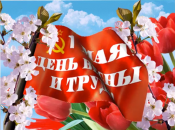
The history of the May Day Holiday of Spring and Labor
May 1 celebrates Spring and Labor Day in Russia. The holiday is a symbol of spring, work on the earth, it personifies respect for any productive labor. Rallies, competition and concert programs, promotions and flash mobs are held throughout the country in cultural institutions, squares and streets, parks and gardens.
The tradition to celebrate this holiday has been around for many years.
The Presidential Library's collections contain dozens of photographs from the pre-revolutionary period and today that reflect the atmosphere of this day. Among them are unique, such as, say, the work of Alexander and Victor Bulla “Workers’ deputation on Palace Square on May 1” of 1917 and “Sketches of posters for performances of mobile theatrical groups celebrating May 1, 1920” by artist Sarah Lebedeva.
One of the fundamental materials presented on the Presidential Library's portal on the history of the celebration of May 1 is the First of May Anthology of 1924, which gives a complete idea of the dynamics of the holiday in our country and abroad.
In July 1889, the Paris Congress of the Second International, in memory of the workers' speech in Chicago, who organized a strike on May 1, 1886, demanding an 8-hour working day (it ended with a bloody clash with the police), decided to establish an International Solidarity Day for the working people.
The public resolution noted: “A great international demonstration is appointed in a fixed number once and for all, so that at once, in all countries and cities, workers presented to the authorities demands to restrict the law of the working day to 8 hours, as well as to fulfill all other decisions of the International Congress in Paris... nations organize this manifestation in the way that will be prompted by the conditions of their country... ”
In the Russian Empire, the Day of International Solidarity of Workers was first celebrated in 1890 in Warsaw by holding a strike that brought together 10 thousand workers.
In 1891 a group of social democrats of M. I. Brusnev organized in St. Petersburg the first May Day meeting - an illegal revolutionary meeting of workers, usually organized outside the city. There were about 200 people who came to the conclusion that it was necessary to unite for a joint struggle. Since 1897, May Day meetings began to be political in nature and were accompanied by mass demonstrations.
In 1901, at the initiative of the Iskra newspaper the general party May Day Proclamation of the RSDLP (Russian Social Democratic Labor Party), which formulated the political tasks of the proletariat was published. At the demonstrations in Gomel, Tiflis and Kharkov, the slogans “Down with autocracy!” And “Long live the republic!” were heard for the first time, and in Petersburg the first collision of the workers' demonstration with the troops took place. In 1905, May Day was celebrated in 177 cities and industrial zones of Russia.
In 1912, 400 thousand workers took part in May Day strikes and meetings, a year later their number increased to 420 thousand, in 1914 - to 500 thousand. There were demands for an 8-hour working day, the confiscation of landlords' lands, the overthrow of the autocracy. Subsequently, the number of participants in the May Day demonstrations increased annually, except for workers, peasants, soldiers and sailors took part in them.
After the victory of the February Revolution of 1917, May 1 was first celebrated freely with slogans: “All power to the Soviets!”, “Down with the imperialist war!”.
After the October Revolution, the First of May became a public holiday. On this day there were demonstrations of workers and military parades. In 1992, the International Day of Workers' Solidarity was renamed Spring and Labor Day.

